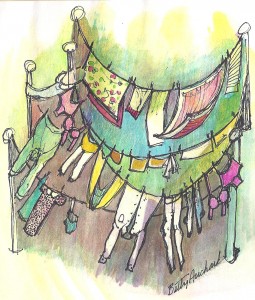Holes Happen
Sometimes you dig a hole for a good reason and sometimes holes just happen. The news reports that the earth has opened up and swallowed sidewalks and cars. Now those are pretty big holes. Little sinkholes have appeared in my back yard and they cause us to trip, which brings us to the conclusion that most holes should eventually be filled up. Why? Because the space they occupy is wasted and could be used again.
Examples: the hole in my tire; the hole in my heart when a boyfriend dumped me; the depressions in my lawn where the earth caved in, and the two-foot pit we dug for our Doggie Dooley (a sort of waste station for dog poops).
All of the above holes were real. The tire had to be pumped up all the time; the old boyfriend had said, “You walk too fast. I’m outta here,” and the hole in my heart took a while to heal. The lawn holes caused us to stumble and fall. So we watch our step until they’re filled in. The Doggie Dooley took a lot of time to dig since the opening had to be the exact size of the metal flange that fit into the top so the lid could cover it up. That’s where we dumped the dog “logs” and then sprinkled magic powder on top of the pile to turn it to compost. The lid kept people from accidentally disappearing into the opening. We filled it with dirt again after our dogs died and planted a flowering vine that grew as fast as Jack’s beanstalk. No wonder.
Those holes are behind me now, but a new batch turned up recently. One of my adult grandsons called and said, “Nonnie, can I come for a visit?” I was delighted. “I need to use your washing machine because the one in my apartment house is always busy.” So he “visited” my Magtag and was folding his socks and said, “These darn holes…”
“In all of my socks,” he said. “I should just buy new ones and throw these away.”
“Oh no; don’t throw those socks away. Let me darn those darn holes.”
“Do what to these darn holes?”
I said, “Darn them.”
“You mean like cussing and swearing at them?”
It was obvious that the darning-holes-in-socks job was no longer part of the English language, so I explained. “Grandson, in the “olden days,” back in 1949, women mended the holes in socks.”
“With a sewing machine?”
“Heavens no; by reconstructing the fabric.”
“How would the fabric be reconstructed?” my grandson asked, so I explained.
“New fabric was created with a needle and darning thread by crisscrossing the strands across the hole as though weaving on a tiny loom. The thread color had to match the sock and a darning egg was pushed inside of the sock heel.”
“A darning…egg?”
I explained that a darning egg was usually made of wood with a little handle. When placed into the sock it made the newly woven area fit the shape of the heel. I used a light bulb in place of my long lost wooden darning egg. I got so caught up in the serene pleasure of mending my grandsons socks that I completely lost track of how much time and work I had put into filling up a sock hole with thread. It was unusually satisfying and the finished product looked like new. I was so proud of my work that I shared the results with everyone in my family and begged to mend their worn out socks so I could bring them back to life.
It takes a lot of time and effort to mend a hole in a sock, but the same is true for anything in life that loses its “wholeness.” We would be happier, be better company, and feel more fulfilled if we’d just take time to fill up those darn holes.
With no warning it died this morning, and it was only 25 years old. My deluxe top-of-the-line 1986 clothes dryer chugalugged, choked, then came to a stop. I was in shock. I had a profound connection with that machine so I needed an hour to grieve. I snapped out of it and lifted the wet sheets out and slopped them into a laundry basket and then to my car. I headed for the High and Dry Laundromat a few blocks away, lugged the heavy basket inside and waited my turn for a washing machine to spin out the water and then kept my eyes open for an empty dryer. A gray metal folding chair beckoned me to sit, so I did while I daydreamed about installing an old-fashioned clothes line in the back yard. What direction should I place it? If it’s the wrong way while wind is blowing the sheets will wind around the line instead of flapping in the breeze. And there are rules about how things are hung. I started reviewing them in my head.
I must never hang laundry outside on Sunday because it just isn’t done.
Before using the line it must be wiped clean with a wet cloth.
Sheets and towels go on the outside lines and underwear hangs out-of-sight on the inside.
Don’t’ use two clothes pins for one item, as one pin can be shared with the next item.
Never leave clothes pins on an empty line because it’s tacky.
If the weather is below zero the clothes will freeze dry and the whites will be whiter.
Before dinner, all laundry must be off the line, folded, and put away.
As these thoughts of a simpler life style flitted through my head I felt self-righteous and honorable. Visions of tribal women washing garments in the creek connected me to my ancestors and I could see them draping wet clothing to dry over bushes and boulders. How strange, feeling bonded to ancient relatives while waiting my turn for an electric clothes dryer.
Drying laundry reminded me of an old-fashioned poem that someone had sent. It stated that the clothesline was a free newspaper because by “reading” the clothesline you could tell what was going on in the neighbor’s house. If the family had been sick with stomach flu there would be extra sheets, nightclothes, and bathrobes hanging there. If they were having company the fancy tablecloths would be flapping in the breeze. If the lines were bare the folks were probably on vacation. If there was no inch to spare they had probably returned. The only stanza I remembered by heart was at the end:
Clotheslines are now of the past for dryers make work less.
What goes on inside a home is now anybody’s guess.
I really miss that way of life. It was a friendly sign
when neighbors knew each other best
by what hung on the line.
“Ma’am, I’m finished. You can have the dryer now.”
A man’s voice snatched me back to the High and Dry Laundromat. I grabbed those sheets and pillow cases, slung them into the dryer and set it on high, glad to be getting this job behind me. The fantasy of installing a clothes line disappeared in a puff of daydreams. I got real and wondered what kind of dryer to buy.













